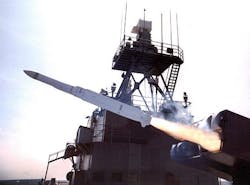Raytheon gets order for ESSM shipboard missiles
Officials of the Naval Sea Systems Command in Washington are asking the Raytheon Missile Systems segment in Tucson, Ariz., also to provide inert operation missiles, spare components, shipping containers, and production support.
ESSM provides anti-ship missile defense to the U.S., NATO, and other allies such as Australia, Belgium, Canada, Denmark, Germany, Greece, the Netherlands, Norway, Portugal, Spain, and Turkey.
The ESSM is a development of the RIM-7 Sea Sparrow missile, and compared to its predecessor has a larger, more powerful rocket motor for increased range and agility, as well as upgraded aerodynamics using strakes and skid-to-turn. Strakes are control fins near the front of the missile.
Related: Raytheon moves to full-scale development of RIM-162 ESSM Block 2 ship-defense missile
ESSM is a medium-range, semi-active homing missile that makes flight corrections via radar and midcourse data uplinks. The missile provides reliable ship self-defense capability against agile, high-speed, low-altitude anti-ship cruise missiles, low velocity air threats like helicopters, and high-speed, maneuverable surface threats.
The missile is 12 feet long and has 10-inch-diameter control and rocket motor sections that tapper to an 8-inch-diameter guidance section with a radome-protected antenna for semi-active homing and a warhead. It has a high-thrust, solid-propellant rocket motor and tail control via a thrust vector controller.
The first production ESSM Block 1 was delivered in late 2002 and has been in full operational use in the U.S. since 2004.
ESSM uses modern missile guidance technology, with different versions for Aegis/AN/SPY-1, Sewaco/Active Phased Array Radar (APAR), and traditional target illumination all-the-way. By 2020 the ESSM will start making way for the more advanced ESSM Block II, which will have a dual-mode X-band seeker, increased maneuverability, and other enhancements.
Related: Raytheon awarded $212.8 million to produce Evolved Seasparrow Missile
Unlike Block 1, Block II’s active seeker will support terminal engagement without the launch ship’s target illumination radars. Raytheon moved to full-scale development of the ESSM Block II in April 2015.
Compared with its ESSM Block 1 predecessor, the ESSM Block 2 missile will have increased maneuverability and other enhancements that will enable it to defeat future threats to U.S. and allied navies operating in hostile environments, Raytheon officials say.
On Friday's order Raytheon and its subcontractors will do the work in Tucson, Ariz.; Germany; Australia; Andover, Mass.; Canada; Norway; Spain; Keyser, W.Va.; the Netherlands; San Jose, Calif.; McKinney, Texas; Turkey; Cincinnati; Greece; Mountain View, Calif.; and other locations, and should be finished by March 2020.
For more information contact Raytheon Missile Systems online at www.raytheon.com, or Naval Sea Systems Command at www.navsea.navy.mil.
Learn more: search the Aerospace & Defense Buyer's Guide for companies, new products, press releases, and videos
